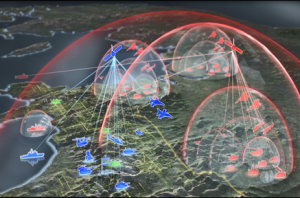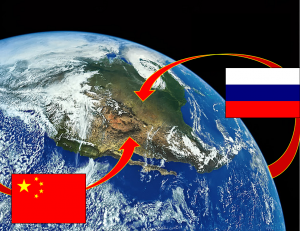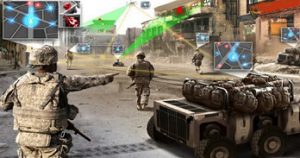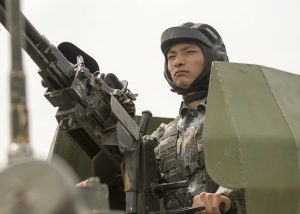[Editor’s Note: The United States Army faces multiple, complex challenges in tomorrow’s Operational Environment (OE), confronting strategic competitors in an increasingly contested space across every domain (land, air, maritime, space, and cyberspace). The Mad Scientist Initiative, the U.S. Army Training and Doctrine Command (TRADOC) G-2 Futures, and Army Futures Command (AFC) Future Operational Environment Cell have collaborated with representatives from industry, academia, and the Intelligence Community to explore the blurring lines between competition and conflict, and the character of great power warfare in the future. Today’s post captures our key findings regarding the OE and what will be required to successfully compete, fight, and win in it — Enjoy!].
Alternative Views of Warfare: The U.S. Army’s view of the possible return to Large Scale Combat Operations (LSCO) and capital systems warfare might not  be the future of warfare. Near-peer competitors will seek to achieve national objectives through competition short of conflict, and regional competitors and non-state actors will effectively compete and fight with smaller, cheaper, and greater numbers of systems against our smaller number of exquisite systems. However, preparation for LSCO and great state warfare may actually contribute to its prevention.
be the future of warfare. Near-peer competitors will seek to achieve national objectives through competition short of conflict, and regional competitors and non-state actors will effectively compete and fight with smaller, cheaper, and greater numbers of systems against our smaller number of exquisite systems. However, preparation for LSCO and great state warfare may actually contribute to its prevention.
Competition and Conflict are Blurring: The dichotomy of war and peace is no longer a useful construct for thinking about national security or the development of land force capabilities. There are no longer defined transitions from peace to war and competition to conflict. This state of simultaneous competition and conflict is continuous and dynamic,  but not necessarily cyclical. Potential adversaries will seek to achieve their national interest short of conflict and will use a range of actions from cyber to kinetic against unmanned systems walking up to the line of a short or protracted armed conflict. Authoritarian regimes are able to more easily ensure unity of effort and whole-of-government over Western democracies and work to exploit fractures and gaps in decision-making, governance, and policy.
but not necessarily cyclical. Potential adversaries will seek to achieve their national interest short of conflict and will use a range of actions from cyber to kinetic against unmanned systems walking up to the line of a short or protracted armed conflict. Authoritarian regimes are able to more easily ensure unity of effort and whole-of-government over Western democracies and work to exploit fractures and gaps in decision-making, governance, and policy.
The globalization of the world – in communications, commerce, and belligerence (short of war) – as well as the fragmentation of societies and splintering of identities has created new factions and “tribes,” and opened the aperture on who has offensive capabilities that were previously limited to state actors. Additionally, the concept of competition itself has broadened as social media, digital finance, smart technology, and online essential services add to a growing target area.
Adversaries seek to shape public opinion and influence decisions through targeted information operations campaigns, often relying on weaponized social media. Competitors invest heavily in research and development in burgeoning technology fields – Artificial Intelligence (Al), quantum sciences, and biotech – and engage in technology theft to weaken U.S. technological superiority. Cyber attacks and probing are used to undermine confidence in financial institutions and critical government and public functions – Supervisory Control and Data Acquisition (SCADA), voting, banking, and governance. Competition and conflict are occurring in all instruments of power throughout the entirety of the Diplomatic, Information, Military and Economic (DIME) model.
and biotech – and engage in technology theft to weaken U.S. technological superiority. Cyber attacks and probing are used to undermine confidence in financial institutions and critical government and public functions – Supervisory Control and Data Acquisition (SCADA), voting, banking, and governance. Competition and conflict are occurring in all instruments of power throughout the entirety of the Diplomatic, Information, Military and Economic (DIME) model.
Cyber actions raise the question of what is the threshold to be considered an act of war. If an adversary launches a cyber attack against a critical financial institution and an economic crisis results – is it an act of war? There is a similar concern regarding unmanned assets. While the kinetic destruction of an unmanned system may cost millions, no lives are lost. How much damage without human loss of life is acceptable?
Nuclear Deterrence limits Great Power Warfare: Multi-Domain Operations (MDO) is predicated on a return to Great Power warfare. However, nuclear deterrence could make that eventuality less likely. The U.S. may be competing more often below the threshold of conventional war and the decisive battles of the 20th Century (e.g., Midway and Operation Overlord). The two most threatening adversaries – Russia and China – have  substantial nuclear arsenals, as does the United States, which will continue to make Great Power conventional warfare a high risk / high cost endeavor. The availability of non-nuclear capabilities that can deliver regional and global effects is a new attribute of the OE. This further complicates the deterrence value of militaries and the escalation theory behind flexible deterrent options. The inherent implications of cyber effects in the real world – especially in economies, government functions, and essential services – further exacerbates the blurring between competition and conflict.
substantial nuclear arsenals, as does the United States, which will continue to make Great Power conventional warfare a high risk / high cost endeavor. The availability of non-nuclear capabilities that can deliver regional and global effects is a new attribute of the OE. This further complicates the deterrence value of militaries and the escalation theory behind flexible deterrent options. The inherent implications of cyber effects in the real world – especially in economies, government functions, and essential services – further exacerbates the blurring between competition and conflict.
Hemispheric Competition and Conflict: Over the last twenty years, Russia and China have been viewed as regional competitors in Eurasia or South-East Asia. These competitors will seek to undermine and fracture traditional Western institutions, democracies, and alliances. Both are transitioning to a hemispheric threat with a  primary focus on challenging the U.S. Army all the way from its home station installations (i.e., the Strategic Support Area) to the Close Area fight. We can expect cyber attacks against critical infrastructure, the use of advanced information warfare such as deep fakes targeting units and families, and the possibility of small scale kinetic attacks during what were once uncontested administrative actions of deployment. There is no institutional memory for this threat and adding time and required speed for deployment is not enough to exercise MDO.
primary focus on challenging the U.S. Army all the way from its home station installations (i.e., the Strategic Support Area) to the Close Area fight. We can expect cyber attacks against critical infrastructure, the use of advanced information warfare such as deep fakes targeting units and families, and the possibility of small scale kinetic attacks during what were once uncontested administrative actions of deployment. There is no institutional memory for this threat and adding time and required speed for deployment is not enough to exercise MDO.
Disposable versus Exquisite: Current thinking espouses technologically advanced and expensive weapons platforms over disposable ones, which brings with it an aversion to employ these exquisite platforms in contested domains and an inability to rapidly reconstitute them once they are committed and  subsequently attrited. In LSCO with a near-peer competitor, the ability to reconstitute will be imperative. The Army (and larger DoD) may need to shift away from large and expensive systems to cheap, scalable, and potentially even disposable unmanned systems (UxS). Additionally, the increases in miniaturized computing power in cheaper systems, coupled with advances in machine learning could lead to massed precision rather than sacrificing precision for mass and vice versa.
subsequently attrited. In LSCO with a near-peer competitor, the ability to reconstitute will be imperative. The Army (and larger DoD) may need to shift away from large and expensive systems to cheap, scalable, and potentially even disposable unmanned systems (UxS). Additionally, the increases in miniaturized computing power in cheaper systems, coupled with advances in machine learning could lead to massed precision rather than sacrificing precision for mass and vice versa.
This challenge is exacerbated by the ability for this new form of mass to quickly aggregate/disaggregate, adapt, self-organize, self-heal, and reconstitute, making it largely unpredictable and dynamic. Adopting these capabilities could provide the U.S. Army and allied forces with an opportunity to use mass precision to disrupt enemy Observe, Orient, Decide, and Act (OODA) loops, confuse kill chains/webs, overwhelm limited adversary formations, and exploit vulnerabilities in extended logistics tails and advanced but immature communication networks.
Human-Starts-the-Loop: There have been numerous discussions and debate over whether armed forces will continue to have a “man-in-the-loop” regarding Lethal Autonomous Weapons Systems (LAWS). Lethal autonomy in future warfare may instead be “human-starts-the-loop,” meaning that humans will be involved in the development of weapons/targeting systems – establishing rules and scripts – and will initiate the process, but will then allow the system to operate autonomously. It has been stated that it would be ethically disingenuous to  remain constrained by “human-on-the-loop” or “human-in-the-loop” constructs when our adversaries are unlikely to similarly restrict their own autonomous warfighting capabilities. Further, the employment of this approach could impact the Army’s MDO strategy. The effects of “human-starts-the-loop” on the kill chain – shortening, flattening, or otherwise dispersing – would necessitate changes in force structuring that could maximize resource allocation in personnel, platforms, and materiel. This scenario presents the Army with an opportunity to execute MDO successfully with increased cost savings, by: 1) Conducting independent maneuver – more agile and streamlined units moving rapidly; 2) Employing cross-domain fires – efficiency and speed in targeting and execution; 3) Maximizing human potential – putting capable Warfighters in optimal positions; and 4) Fielding in echelons above brigade – flattening command structures and increasing efficiency.
remain constrained by “human-on-the-loop” or “human-in-the-loop” constructs when our adversaries are unlikely to similarly restrict their own autonomous warfighting capabilities. Further, the employment of this approach could impact the Army’s MDO strategy. The effects of “human-starts-the-loop” on the kill chain – shortening, flattening, or otherwise dispersing – would necessitate changes in force structuring that could maximize resource allocation in personnel, platforms, and materiel. This scenario presents the Army with an opportunity to execute MDO successfully with increased cost savings, by: 1) Conducting independent maneuver – more agile and streamlined units moving rapidly; 2) Employing cross-domain fires – efficiency and speed in targeting and execution; 3) Maximizing human potential – putting capable Warfighters in optimal positions; and 4) Fielding in echelons above brigade – flattening command structures and increasing efficiency.
Emulation and the Accumulation of Advantages: China and Russia are emulating many U.S. Department of Defense modernization and training initiatives.  China now has Combat Training Centers. Russia has programs that mirror the Army’s Cross Functional Team initiatives and the Artificial Intelligence (AI) Task Force. China and Russia are undergoing their own versions of force modernization to better professionalize the ranks and improve operational reach. Within these different technical spaces, both China and Russia are accumulating advantages that they envision will blunt traditional U.S. combat advantages and the tenets described in MDO. However, both nations remain vulnerable and dependent on U.S. innovations in microelectronics, as well as the challenges of incorporating these technologies into their own doctrine, training, and cultures.
China now has Combat Training Centers. Russia has programs that mirror the Army’s Cross Functional Team initiatives and the Artificial Intelligence (AI) Task Force. China and Russia are undergoing their own versions of force modernization to better professionalize the ranks and improve operational reach. Within these different technical spaces, both China and Russia are accumulating advantages that they envision will blunt traditional U.S. combat advantages and the tenets described in MDO. However, both nations remain vulnerable and dependent on U.S. innovations in microelectronics, as well as the challenges of incorporating these technologies into their own doctrine, training, and cultures.
If you enjoyed this post, please also see:
Jomini’s Revenge: Mass Strikes Back! by Zachery Tyson Brown.
Our “Tenth Man” – Challenging our Assumptions about the Operational Environment and Warfare posts, where Part 1 discusses whether the future fight will necessarily even involve LSCO and Part 2 addresses the implications of a changed or changing nature of war.
The Death of Authenticity: New Era Information Warfare.



